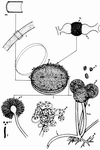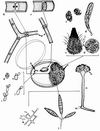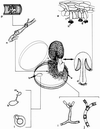Developments in fungal taxonomy
- PMID: 10398676
- PMCID: PMC100249
- DOI: 10.1128/CMR.12.3.454
Developments in fungal taxonomy
Abstract
Fungal infections, especially those caused by opportunistic species, have become substantially more common in recent decades. Numerous species cause human infections, and several new human pathogens are discovered yearly. This situation has created an increasing interest in fungal taxonomy and has led to the development of new methods and approaches to fungal biosystematics which have promoted important practical advances in identification procedures. However, the significance of some data provided by the new approaches is still unclear, and results drawn from such studies may even increase nomenclatural confusion. Analyses of rRNA and rDNA sequences constitute an important complement of the morphological criteria needed to allow clinical fungi to be more easily identified and placed on a single phylogenetic tree. Most of the pathogenic fungi so far described belong to the kingdom Fungi; two belong to the kingdom Chromista. Within the Fungi, they are distributed in three phyla and in 15 orders (Pneumocystidales, Saccharomycetales, Dothideales, Sordariales, Onygenales, Eurotiales, Hypocreales, Ophiostomatales, Microascales, Tremellales, Poriales, Stereales, Agaricales, Schizophyllales, and Ustilaginales).
Figures






References
-
- Ajello L. The isolation of Allescheria boydii Shear, an etiologic agent of mycetomas, from soil. Am J Trop Med Hyg. 1952;1:227–238. - PubMed
-
- Ajello L. A taxonomic review of the dermatophytes and related species. Sabouraudia. 1968;6:147–159. - PubMed
-
- Ajello L, Kaplan W. A new variant of Sporothrix schenckii. Mykosen. 1969;12:633–644. - PubMed
-
- Aliouat E M, Mazars E, Dei-Cas E, Cesbron J Y, Camus D. Intranasal inoculation of mouse, rat or rabbit-derived Pneumocystis in SCID mice. J Protozool Res. 1993;3:94–98.
Publication types
MeSH terms
Substances
LinkOut - more resources
Full Text Sources
Other Literature Sources
Medical

